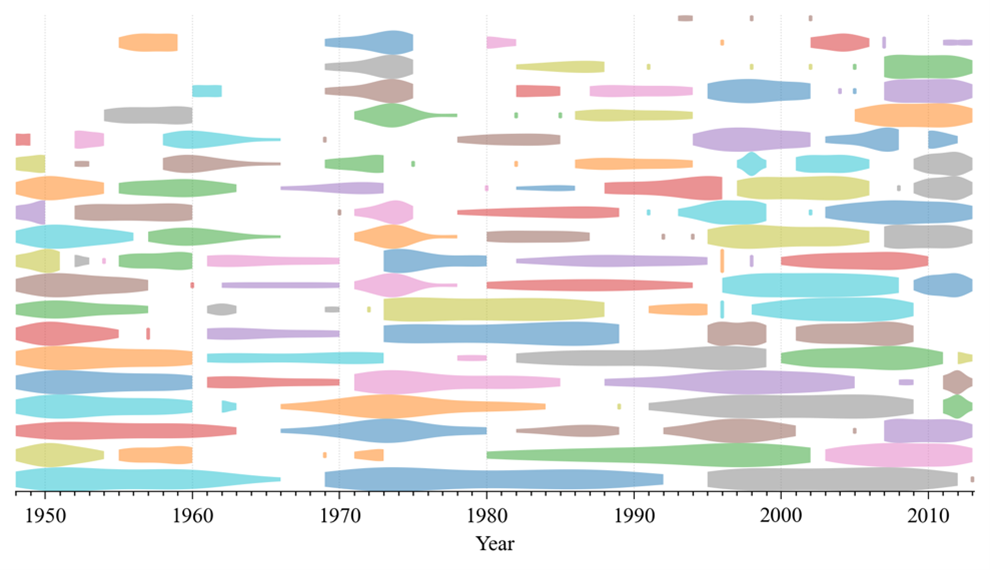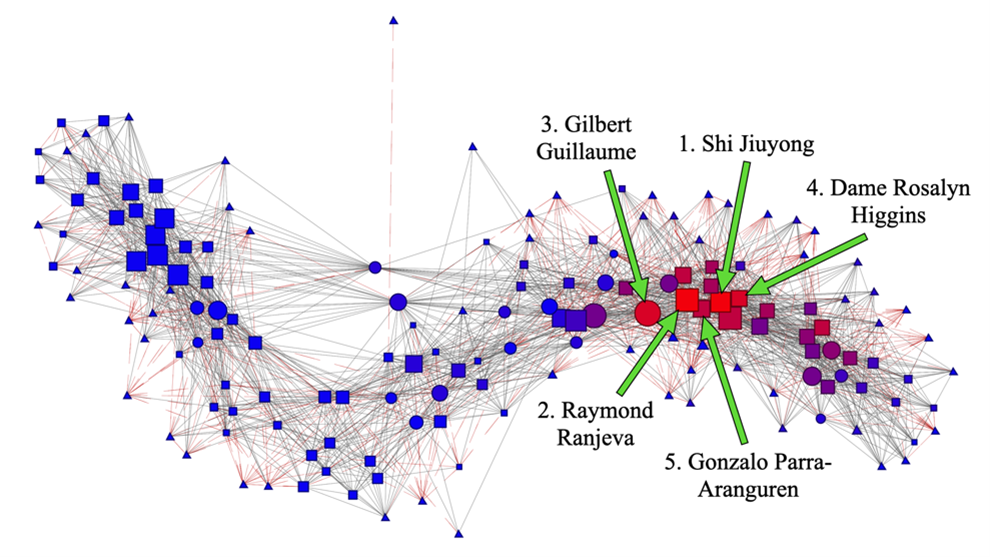
Precedent builds at the International Court of Justice but falls short of its role at the US Supreme Court
By Daniele Bellutta
Paper reference
Bellutta, Daniele, & Carley, Kathleen M. (2024). “Indicators of the formation of precedent at the International Court of Justice”. Social Networks 79: 1–13. doi: 10.1016/j.socnet.2024.04.00
Over recent months, numerous news reports have covered cases being heard at the International Court of Justice (ICJ) related to both Russia’s invasion of Ukraine and the current conflict in Gaza, the latter of which has sparked a remarkable three cases at the Court. But as the main judicial body of the United Nations, the ICJ has been ruling on important disputes between countries for many decades since its beginnings in 1946. Over more than 170 cases, the ICJ has applied international treaties, customs, and principles to issue decisions on matters ranging from contested borders and maritime activity to the actions of military forces and the treatment of foreign citizens.
At this point, readers more familiar with the precedent-based functioning of the US Supreme Court may be worried at the prospect of a group of judges creating new international law from a place as far away as the Hague. Though not an unreasonable concern, the statute that created the ICJ explicitly prevents the Court from regarding its previous rulings as binding on other cases, which sets it apart from the principle of stare decisis employed by the US Supreme Court. However, that does not necessarily stop the ICJ from generally tending to agree with its prior decisions, as indeed it should if its application of international law is fair and consistent. Given that tendency, some legal scholars have suggested that the Court’s decisions have formed a body of precedent that could help indicate how the ICJ might evaluate arguments in future cases.
Our new research on ICJ decisions issued from 1948 to 2013 has shown that though a system of precedent does seem to be evolving at the Court, its strength is far from what would be seen for a common law tribunal such as the US Supreme Court. By studying the citation network formed from the ICJ rulings’ references to past judgements, we found that the extent to which a decision relied on significant prior rulings was only slightly predictive of how much that decision would be cited in the future. Though this supports other scholars’ conclusions that precedent is becoming more important in litigation at the Court, our results also fell significantly short of the findings reported in a similar study on the US Supreme Court, meaning that the ICJ is far from becoming a common law body.
Figure: The ICJ citation network from 1948 to 2013. Larger decisions cited particularly important cases, whereas redder decisions were cited by particularly important rulings. The labeled decisions ranked highly across various measures of importance.
To further evaluate the significance of precedent at the ICJ, we additionally studied whether particular judges could be regarded as having more influential stances than others. Using the judges’ individual votes on the Court’s decisions, we constructed networks revealing the agreement or disagreement between judges and identified those who seemed to frequently agree with many other judges or who tended to agree with other agreeable judges. We then tested whether the rulings supported by these standout judges were more likely to be cited in the future, which could indicate that those judges held more influential positions. Our results showed that though this was indeed the case, the strength of that relationship was quite weak. This means that studying the principles and votes of individual judges could only provide a very small amount of insight into which issues could impact future decision making at the ICJ.
 Figure: The timeline of judge votes at the ICJ from 1948 to 2013. Each shape represents a judge, with wider parts representing more votes.
Figure: The timeline of judge votes at the ICJ from 1948 to 2013. Each shape represents a judge, with wider parts representing more votes.
 Figure: The agreement network between ICJ judges from 1948 to 2013. Dashed red lines indicate disagreement, whereas solid gray lines indicate agreement. Judges are sized by the number of votes they cast, and redder judges agreed more with other agreeable judges. The labeled judges ranked as being the most agreeable.
Figure: The agreement network between ICJ judges from 1948 to 2013. Dashed red lines indicate disagreement, whereas solid gray lines indicate agreement. Judges are sized by the number of votes they cast, and redder judges agreed more with other agreeable judges. The labeled judges ranked as being the most agreeable.
Overall, our work supports previous research identifying the increasing importance of precedent at the ICJ but also tempers conclusions that the Court has become more similar to a common law system. Though the results give some weight to claims that litigation at the ICJ is becoming more complex as familiarity with the Court’s history becomes more beneficial for crafting arguments, our research indicates that concerns over increasing barriers to access or expanding judge-made law should not be overblown. Litigants at the ICJ should be reassured that the Court appears to balance the desire for consistent application of international law with the limits placed upon its creative power.
Aside from evaluating the behavior of the ICJ in particular, our research has also demonstrated the usefulness of new techniques for studying judicial citation networks in general. We showed that reverse page-rank was more effective than other metrics at evaluating the degree to which an ICJ ruling was grounded in strong precedent and was more likely to be cited in the future. Our approach to studying the agreement between judges could also be combined with other algorithms to evaluate polarization between court members or to identify groups of judges with similar beliefs, and it could even be applied to other decision-making bodies, such as legislatures across the world. Consequently, our work is relevant to research beyond the study of the ICJ.
Main results
- In citing its precedent, the International Court of Justice balances the need for consistency with the limits on its authority.
- The reverse page-rank metric is better able to identify future sources of precedent than other measures.
- Mapping the agreement between judges highlights those with more influential legal stances.
